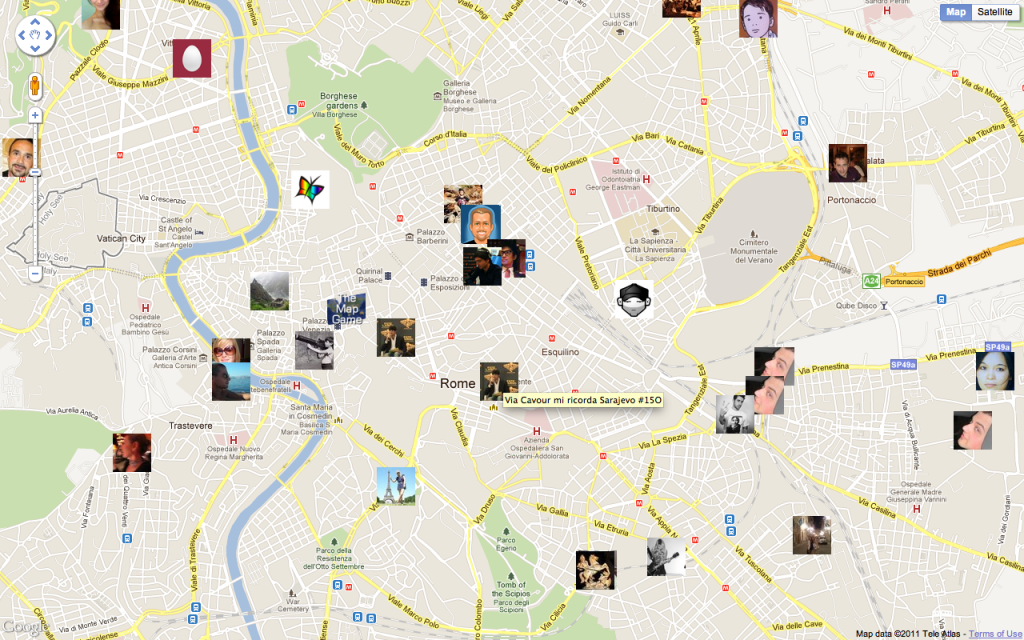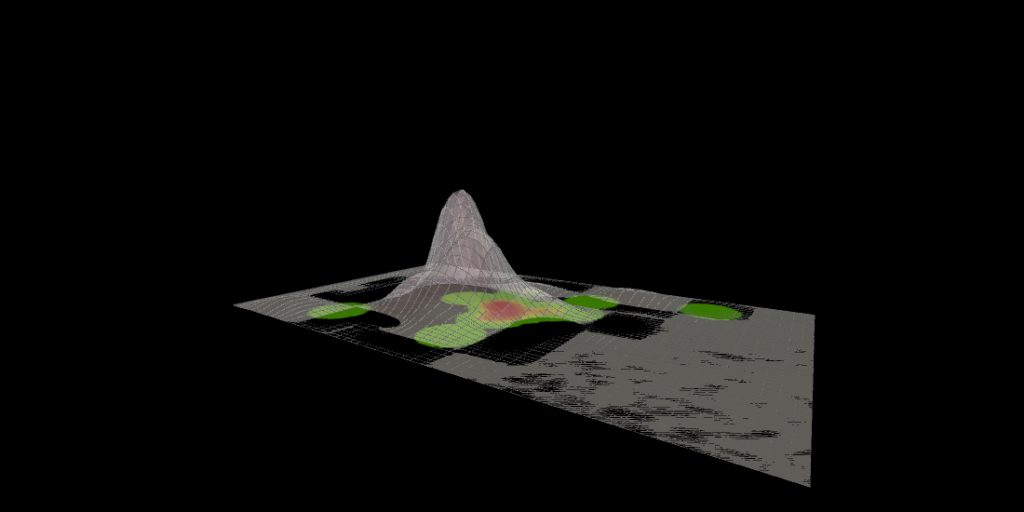This short video displays the activity on social networks (Twitter, Facebook, Foursquare) during the riots of October 15th which took place in Rome during the local instance of the 15th October initiative created in the planetary process started by the Occupy Wall Street movement.
The peaks and contours you see represent the intensity of the communication and conversations that was taking place from the start of the protest (at 3pm local time) up until its approximate end (at 8pm local time).
The animation shows the geo-referenced intensity of messages for each 30 minute time slot from the beginning to the end of the protest.
Messages have been captured using the publicly available APIs made available by the operators of these social networks and do not represent the totality of the conversations as:
- some of them were not geo-referenced
- there are limits in the public APIs, which cause the loss of some messages and the need to stop the capture process every few minutes to restore the connection
Even with these limitations taken into account, a massive number of communications and conversations has been captured, processed and represented in the visualization (around 20000).
The 3D visualization was juxtaposed to a realtime location based one like this one below:
In this visualization geo-referenced social network messages pop up with the avatar icon of their author, as soon as they are created.
We were very sad about Rome’s protest on October 15th: the peaceful protest, the only one whose interest was to actually try to oppose the difficult situation of our planet, was completely overwhelmed by the violent one.
By looking at the peaks of intensity of communication on social networks and the other info visualizations, it is clear how most of the online conversation was focused on the violent riots. And this is also strongly reflected in older media such as TV news, newspapers and their websites.
It is time to invent new, innovative, creative forms of protest, fostering new forms of solidarety, collaboration, participation between people, and also to create tools, strategies and methodologies to bypass and overcome the tricks which power structures and the people and organizations which we want to fight against have learned to perform so well to dismantle and make disappear all the good parts of the critique coming from the peaceful protesters.
What we suggest is to create new forms of protest. Which do not look anything like these current ones.
Digital technologies can become truly useful tools for this. That is: if we care enough to reinvent ourselves and our practices and, thus, we take into account the need/possibility of inventing new tools and methodologies.
While we all evaluate what happened yesterday, on October 15th, we wish to make a couple of observations:
- even a simple tool like this one (the realtime visualizations and the possibility to “read” the digital conversations around us as soon as they happen) could prove incredibly useful in situations like the violent ones happened yesterday
- in multiple instances, valuable information on what was happening in other parts of the protest were spread on the network, but they were not coordinated nor people were aware that they could have been used and re-diffused to create a layer of digital intelligence that could have drastically changed the scenario
- for example: multiple messages were suggesting a drastic change to the original path of the protest, and many, many of them tried to communicate to other people the presence of violence and danger in specific parts of the city; these messages had a very low propagation profile (understandable for example, by measuring their number of re-tweets or shares or propagation to other social networks), showing how they were not part of a diffused state of awareness that such information could/should be accessed/used by multiple people at a strategic level, to provide a network based diffused intelligence that could support in incredibly effective ways the dynamic, realtime tuning of strategies and decisions
- or, if we analyze the data around Piazza S. Giovanni in Laterano where the main clashes took place, we are able to see very precise, realtime information about the dislocation of dangerous scenarios or very informative updates to the realtime development of the events near and far along the protest; if you have ever been caught in the middle of a violent protest you will know that this kind of information is extremely valuable: in a scenario of limited visibility due to tear gas and explosions, of extreme noises, and of common misinformation being able to know for sure in which direction to walk to avoid being hurt, or to support people who are in danger or in need of help is incredibly useful.
- Furthermore, such practices could/should be used by institutions and police, if they really care about the health and wellness of the population, for both pro-activity and monitoring the emergence of situations
- services should be setup to alert people about possible alternatives, to suggest deviations and countermeasures to isolate the violent fringes or to safely bypass dangerous spots: imagine the effectiveness of a service which, according to your position, gives you realtime visual information on where to go to safely re-join the peaceful protest or where to get help, or where is a safe meeting spot to reassemble with your friends
- situations could be monitored since their emergence; for example yesterday hundreds of people wrote messages about the position of the violent fringes of the protest and very precise accounts of their realtime activities; by simply reading this information the police would have had plenty of information to gain a significant strategic advantage and surround/isolate them: imagine it, they had thousands of people describing the actions and movements of the violent ones.
- the question is, obviously, “do they want to care for the health and wellness of people?” But that is an entirely different questions and, starting from the critical movements of the 60s and 70s, we know a whole series of disturbing answers.
These and other topics will be discussed at the Share Festival and at the FabLab Italia during the first week of November 2011, where we will present the “VersuS” project.
VersuS is a spin-off of the ConnectiCity project, and is intended to create tools that enable us to imagine, design and create new tools for the city.
In VersuS the possibility to capture and understand the conversations on social networks is transformed into a tool with infinite uses, whose main goal is to propose new forms of citizenship and human relation, and to also suggest institutions and organizations new methodologies and strategies to innovate their understanding of their cities and to design and enact strategies which leverage new possible sensibilities to the desires, wishes and creativity of people.
A suggestion about the fact that change is possible.
VersuS is done using Processing as well as several other technologies for the realtime social network analysis.
The full code as well as the final version of the visualization and some 3D prints of the riots as seen from social networks, together with other concepts for usage of these technologies and methodologies in arts, sciences, intitutions, business and activism will be on show at the Share Festival in the first week of November 2011.
Updates (Oct. 18th 2011):
thank you for the support we’re receiving! We will be organizing the data in usable formats and will release everything (datasets and software) in the next few days so that everyone interested can validate it and use it for their researches and projects. And if you do: please keep us informed! We’d love to know more about it.
And if you can please consider coming to the Share Festival at our conference on Ubiquitous Fabbing on November 3rd in Turin at the Stazione Futuro where we will present and discuss the project in detail.
In these hours VersuS appeared here:
on Centro Studi Etnografia Digitale
on BoingBoing, mentioned by our dear friend Jasmina Tesanovic
Thanks!
![[ AOS ] Art is Open Source](https://www.artisopensource.net/network/artisopensource/wp-content/uploads/2020/03/AOSLogo-01.png)


